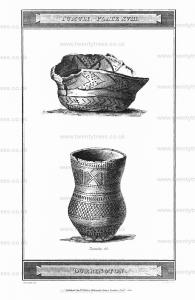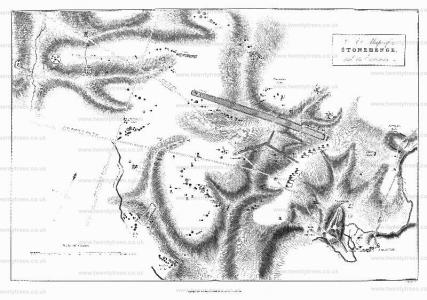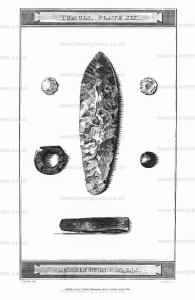Station 5 Amesbury North
Station 5 Amesbury North is in The Ancient History of Wiltshire by Richard Colt Hoare Volume 1.
Books, Prehistory, The Ancient History of Wiltshire by Richard Colt Hoare Volume 1, Station 5 Amesbury North, Durrington Barrows ![]()
On the opposite hill is a beautiful group of tumuli, thickly strewed over a rich and verdant down. Their perfect appearance raised our expectations of success, and the attendance of many of my friends from Salisbury, and a beautiful day, enlivened our prospects; but we had again sad cause to exclaim Fronti nullaa fides, Trust not to outward appearances. No arrow heads were found to mark the profession of the British hunter; no gilded dagger to point out to us the chieftain of the clan; nor any necklace of amber or jet, to distinguish the British female, or to present to her fair descendants, who honoured us with their presence on this occasion: a few rude urns marked the antiquity and poverty of the Britons who fixed on this spot as their mausoleum, Unproductive, however, as were the contents of these barrows, it may not be uninteresting to the antiquary, whom either chance or curiosity leads across these fine plains, to know their history.
Note 1. On referring to Mr. CUNNINGTON'S papers, find some account of these barrows. The Druid barrows had been partially opened: in one, he found an interment, with a broken dart or lance of brass; and in another, the scattered fragments or burned bones, a Few small amber rings, beads of the same, and of jet, with the point of a brass dart. In opening the large barrow, No. 57 [Map] he found a cist, at the depth twelve feet from the surface, the remainder (as he thought) of the brass dart, and with it a curious whetstone, some ivory tweezers, and some decayed articles of bone.
To the south of No. 80, on the opposite hill, is a Druid barrow [Map] (not inserted in the plan), which produced a large rude urn without an interment.
In the same easterly direction, but nearer to the CURSUS, is another fine group of barrows, equally inviting to the eye, but nearly as unproductive as the preceding.
No. 84 [Map] is the largest barrow in this group, and has been ploughed over. In making our section, we found pieces of stag's horns, pottery, and the remains of a skeleton and drinking cup, and two knives; but the primary interment was a skeleton, with its legs gathered up, and hands placed under its head.
No. 92 [Map]. In digging down to the floor of this barrow, we discovered the remains of a skeleton, with fragments of a funeral urn, burned bones, and some enormous pieces of staff's horns. Within a cist, excavated beneath the floor of the barrow, lay a skeleton with its legs gathered up, and head placed towards the north.
No. 93 [Map] contained, near the top, an interment of burned bones, in a rude broken urn, with a small cup; also, the remains of a skeleton, charred wood, stag's horns, and flint apparently prepared for war-like instruments. The primary deposit was a skeleton, with its head placed towards the south-east, accompanied by fine drinking cap, richly ornamented, and in the highest state of preservation, which I have had engraved in Tumuli Plate XVIII. half the size of the original, in order to shew the pattern more conspicuously.

On the opposite hill, eastward, is another group of nine barrows.
No. 104 [Map] is a large flat circular barrow, which had been opened, and must have proved both interesting and productive to those who first investigated it. In the course of our examination, we found the bones of several skeletons, fragments of urns, and a rude instrument made from a stag's horn; there was also a large and deep cist.
On a rising ground to the north, and a little beyond the barn, is another group of seven barrows.
No. 109 [Map], No. 110 [Map], and No. 111 [Map], had been investigated: on opening the first, we found the soil intermixed with the turf, which clearly indicated a prior opening, We were deterred from making any attempt on the second barrow, by a great cavity in its apex; and we found the third had been examined.
No. 112 [Map] is a double barrow, rising towards the east, and somewhat resembling a long barrow, but ditched all around. The lowest part had been opened, and contained an interment of burned bones. In the other mound, we found an interment of burned bones, secored by a linen cloth under a rude urn.
No. 115 contained also a similar interment, but had been opened before. I had for a long time viewed these two last groups of barrows with satisfaction, and anticipated much pleasure and success, in opening them. I had also reserved them for the gratification of some of my friends in the neighbourhood, who attended our operations: judge then of my mortification and disappointment, in finding that many of them, though with the most even, and apparently maiden surface, had been already investigated, and robbed of their contents; and the remainder either totally unproductive, or uninteresting. Poor indeed were the Britons who once inhabited these plains, unlike their rich neighbours, whose relicts were deposited in the vicinity, and particularly on the southern side of Stonehenge; but though disappointment attended our researches in this district, truth is obtained, and the history of these numerous barrows remains no longer involved in obscurity.
Adjoining the CURSUS, and nearly in a line with it, are a few small barrows.
From hence, I proceed towards the vale of the river Avon, where, adjoining the public road, We find the interesting remains of a spacious British town or village, called Durrington, or Long Walls. The first name is evidently derived from the Celtic word for, water, and applies to the situation of the adjoining village of Durrington near the river. The site of this ancient settlement is decidedly marked by a circular embankment, partly natural, and partly artificial, which shelters it from the south-west winds: the view it commands in front, is delightful, facing the rich and well wooded vale, and the lofty range of Haradon and adjoining hills. Having been for many years in tillage, its form is much mutilated; but from what remains, it appears to have been of a circular form, and to have had a vallum all around it on the high ground, but not on the east side near the water. We picked up a great deal of pottery within the area of the works.
On viewing the country round Stonehenge, and remarking with surprise, the numerous memorials of the dead, so thickly scattered over these extensive plains; we are led naturally to inquire. "Where were the habitations of the living?" This question can be answered in part, but not so fully as could wish, by the discoveries we have made in the British villages, an Winterbourn Stoke, Durrington, and Lake downs; many others would, probably a have been found in the environs of Stonehenge, had not the soil been turned up by the plough. We are fortunate, however, in having rescued so many from oblivion, and to have thrown aside the thick veil which, notwithstanding the active researches of a STUKELEY, has, till this period obscured them.
On the south side of Durrington Walls, is an elevated mound, bearing the appearance of a barrow, No. 122 [Map], in which we dug to the depth of eleven feet, but found no sepulchral marks whatever.
And still further, on the same side of the road, a very singular tumulus, No. 124 [Map], appearing like three barrows rising from one large base, but certainly a long barrow. It stands from south-west to north-east, and has its wide end towards the west: on the small end, and also on the centre, are mounds resembling two circular barrows. We opened that on the small end, and found only a few ashes and charred wood; but in the central mound we discovered, near the top, a skeleton and a drinking cup, both of which had been disturbed. On reaching the floor of the long barrow, we found a circular cist like a little well, but it contained no interment; from this well-like cist, a tunnel, like a chimney, ascended nearly to the top. I imagine that, as in most of our long barrows, the primary interment would be found at the broad end. In this tumulus we have rather a singular instance of a circular barrow being raised upon a long barrow.
No. 125 [Map], in tillage, appears to have been barrow of very large proportions, and there are two others in the corn fields nearer the park, No. 126 [Map], No. 127 [Map], which we have not attempted to open. There are also near them under the hill; same appearances of earthen works much mutilated, which I cannot account for: I once thought they formed part of circle, but I cannot speak with any decision about them.
Before I conclude this Iter, let me call the attention of my readers to the annexed map of Stonehenge, and its environs, in which the hills, roads, antiquities, and barrows are accurately laid down, from actual measurement. In it you will find a striking picture of ancient times. You will see the spot selected by the earliest inhabitants of our island for their residence; you will behold that stupendous monument of antiquity, Stonehenge, the building set apart for their civil or religious assemblies: you will perceive its connexion, by means of the AVENUE, with the CURSUS, a spot appropriated to their games, and races; you will recognize also in the camp vulgarly attributed to the Emperor Vespasian, the strong-hold of the Britons, or the asylum for their families and herds in times of danger: at Durrington, and on Winterbourn Stoke Downs you will see the habitations of the Britons, with the lines of communication, from one village to another; and in the numerous barrows dispersed over this extensive plain, you will distinguish the simple memorials of the mighty dead. In short, you will have clearly traced to your imagination's eye a most impressive history of our ancient Britons.

Yet I do not wish you to suppose that all these antiquities can boast the same remote æra of antiquity; for in them we may clearly distinguish the marks of two distinct people, the Britons, and their conquerors, the Romans. To the first I would attribute the construction of Stonehenge, and the raising of the barrows; to the latter, the cursus1, and the principal remains of the villages; for although we find in them fragments of rude unbaked pottery, yet the well the villages also on Stoke down burned Roman earthen ware preponderates: bear rather a more regular form in their plan, than we usually meet within the original British settlements. That Stonehenge existed before some of the barrows adjoining it, has been clearly proved by the chippings of Stone discovered within them: and that: the custom of burying under tumuli ceased on our downs2 after the arrival of the Romans, is, I think, also proved, by our never having found a single urn either well baked, or turned with the lathe, in any one barrow. At the period when these villages were inhabited by a mixed population of Britons and Romans, whom I call Romanized Britons, they certainly had dropped the custom of burying under barrows, and having no index to direct our spades, we have never been fortunate in discovering the cemeteries of the people who inhabited these British villages.3 Such a discovery would be a grand and most satisfactory desideratum, for, instead of the rude and coarse urn of British pottery, we should then be gratified with specimens of that elegant earthen-ware for which the Romans (copying the Græcian models) were so justly cerebrated. That, even in the rudest times, other modes of burial, besides the barrow, were adopted, we have an interesting proof in an interment which was lately discovered above Durrington Walls, by a shepherd, who in pitching the fold, found his iron bar impeded in the ground: curiosity led him to explore the cause, which proved to be a large sarsen stone, covering the interment of a skeleton, with whose remains the articles were graved in Tumuli Plate XIX were deposited, viz. a spear head chipped from a flint, a small bone or whetstone, a cone and ring of jet like a pully, and two little buttons of marl or chalk, all bespeaking an interment of the earliest date.
Note 1. The cursus so resembles in form the Roman circus, that I am inclined to think its plan was introduced by that nation.
Note 2. When I say that the custom of burying under tumuli appeared to cease on tho mixture of the Romans with the Britons, allude only to own county: for Mr. Douglas, in his Nania Britannica, has clearly proved the same custom was continued in Kent later than the seventh century.
Note 3. If we refer on the map to the Situations of the numerous British villages already described, we shall find only a few scattered barrows around them, a proof that other modes of interment must have been adopted by the inhabitants of them.

It may also be naturally expected that, after quoting the various descriptions and conjectures of others respecting Stonehenge, I should give some opinions of my own. This I shall do with diffidence, and lament that the history of this celebrated wonder of the west will most probably ever remain unknown. I cannot for a moment hesitate in declaring it to be neither Roman, Saxon, nor Danish. We learn from the holy Scriptures that the and find to this day single, double, and earliest memorials were of stone; triple upright stones, as well as numerous circles dispersed about our dominions: we then find some attempt at architecture in the cromlech and kistvaen, in both of which we see immense stones laid incumbent upon others that are upright; whether these gave the idea OF the imposts at Stonehenge, or vice versá, will be a difficult matter to determine; at all events I consider Stonehenge of a much more modern date than ABORY, where there are no imposts, and no marks of working on the stones: but in the former we perceive a regular plan, a great degree of symmetry, and great knowledge in mathematics. We know also that many stone monuments exist on the Continent, and in that part of it, from whence our island probably received its earliest population, viz. GALLIA CELTICA1. I have before stated my opinion, that our earliest inhabitants were Celts, who naturally introduced with them their own buildings, customs, rites, and religious ceremonies; and to them I attribute the erection of Stonehenge, and the greater part of the sepulchral memorials that still continue to render its environs so truly interesting to the antiquary and historian.
Note 1. The most remarkable of these monuments, and such as must excite our curiosity in the highest degree, is situated in the hamlet of Carnac, near Vannes and Auray, on the western coast of Bretagne, and in the department Morbihan, France. Monsieur Cambray, in his Monumens Celtiques, has given a very detailed and animated description of this interesting relict of antiquity. He tells us that some detached stones on the hills, and sand banks, announce the approach to this grand theatre, which consists or an immense heap of rude unhewn stones (amounting to four thousand or more) standing in an upright position on a sandy near the sea coast. They are ranged in eleven straight lines, which lines are separated each other by a space of thirty or thirty-three feet, and the distance from one stone to another varies from twelve to fifteen feet. The highest of these stones measures twenty-two feet out of the ground; the width varies; one of them is twenty-two feet high, twelve feet wide, and six feet thick, and many are moveable; these stones present the most singular aspect: they stand alone on an extensive plain, attended only by the sand that supports them, and the vault of heaven that surrounds them: not an inscription to explain, not an analogy to inform; the men whom you call, the traveller who you interrogate, gaze at it, and either turn away their head, or recount follies. They recall to our memory those times which neither our calculation nor our history can ever attain.
The general title of DRUIDICAL has been given to all these stone monuments: and some of my readers may be surprized that I have not adopted it. That the Druids existed in our island, at a very early period, and officiated as priests, there can be no doubt, but as the learned Mr. Bryant, in his Mythology observes, "Under the sanction of their names we shelter ourselves, whenever we are ignorant and bewildered." And Mr. Borlase, with equal justness remarks, that the work of Stonehenge must have been that of a great and powerful nation, not of a limited community of priests; the grandeur of the design, the distance of the materials, the tediousness with which all such massive works are necessarily attended, all shew, that such designs were the fruits of peace and religion.